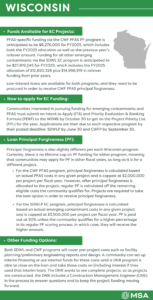In recent years, the United States has prioritized a commitment to protecting the nation’s drinking water and wastewater systems.
This move will safeguard the health of citizens and the natural environment. Behind this commitment is the appropriation of historic levels of funding and the single largest investment in clean water by the federal government.

President Biden signed the Bipartisan Infrastructure Law (BIL) on November 15, 2021, which includes more than $50 billion in funding for the U.S. Environmental Protection Agency (US EPA) to fortify potable and wastewater systems nationwide. $5 billion of the BIL funding has been allotted for the Emerging Contaminants in Small or Disadvantaged Communities (EC-SDC) grant program in fiscal years 2022-2026. This program aims to mitigate harmful effects of a number of emerging contaminants in public water systems and source water within small and disadvantaged communities — PFAS (perfluoroalkyl and polyfluoroalkyl substances), perchlorate, and manganese, to name a few.
On April 10, 2024, the US EPA announced an additional $1 billion in funding to help states and territories implement testing and treatment programs specifically for PFAS in public water systems and homes served by privately owned wells. This funding accompanied the organization’s announcement about its historic final National Primary Drinking Water Regulation (NPDWR) which establishes the first legally enforceable Maximum Contaminant Levels (MCLs) for six PFAS found in drinking water systems.
Emerging Contaminants in Small or Disadvantaged Communities Grant Program
The EC-SDC program was established to address PFAS and emerging contaminants challenges in communities most in need of assistance. It provides grants, not loans, to eligible states and territories and makes awards on a non-competitive basis with no cost share or match requirement. This program, paired with the resources of the Clean Water State Revolving Fund and the Drinking Water State Revolving Fund, will make a meaningful impact in helping to detect, treat and mitigate emerging contaminants in communities. The EC-SDC grant program’s annual appropriation is $1 billion for fiscal years 2022-2026.
In fiscal year 2024, all 56 eligible states and territories are participating in the program.

What Qualifies as a Small or Disadvantaged Community?
The EC-SDC program defines a “small community” as one with a population less than 10,000 which does not, by determination of the program administrator, have the capacity of incur debt sufficient to finance a project or activity under the grant program. A “disadvantaged community” is one determined by the state to be disadvantaged in accordance with a set of affordability criteria established under section 1452(d)(3) of the Safe Drinking Water Act.
Types of Projects Eligible to Receive EC-SDC Funding
To receive EC-SDC funding, the primary purpose of the project must be to address one or more emerging contaminants in drinking water as defined by the EPA’s Contaminant Candidate Lists. There are many types of projects that qualify for EC-SDC funding, from planning and testing to design, technical assistance, and public education. A few examples include the following: emerging contaminants plans, source water protection plans, water quality testing, preliminary engineering reports, alternatives analyses, preliminary and final design for treatment systems, local contractor training, technical assistance, environmental or archaeological reviews, permitting, public communication and education. Costs to make basic drinking water system improvements are not eligible unless they are “directly and reasonably related” to projects addressing emerging contaminants.
State-specific Funding & Program Requirements
BIL EC-SDC funding is a federal pass-through program administered by each state through their existing State Revolving Fund programs. The US EPA announced individual state allotments for fiscal year 2024 on April 10, 2024. Funding amounts were based on an allocation formula including factors such as population, number of water systems, and data related to emerging contaminants. Funding amounts for fiscal year 2025 are estimated, based on allotments for FY2024.
What do we anticipate for FY 2025 and beyond?
Applicants and projects utilizing BIL EC/PFAS funds are subject to BIL requirements and Buy American Preference (BAP or BABA). These requirements will not only increase project costs, but also administrative costs when utilizing federal funds. At this time, most states do not have enough eligible projects to expend their full EC allotments, meaning funds are being carried over to the next fiscal year.
Illinois: The Illinois Environmental Protection Agency (IEPA) administers emerging contaminant funding through the Public Water Supply Loan Program (PWSLP). IEPA is aware of community water systems that are having issues with Manganese/PFAS and anticipates prioritizing projects that address these specific contaminants.

Iowa: The Iowa Department of Natural Resources (IDNR) administers emerging contaminant funding through the Drinking Water State Revolving Fund (DWSRF). Both publicly and privately owned community water systems are eligible for funding.

Minnesota: Minnesota will receive $17 million over five years to address emerging contaminants through the Bipartisan Infrastructure Law (BIL). Currently, the funding program is in the third year with about $16 million in funds yet to be received by Minnesota. $3.9 million will be available in the 2025 funding year (current year) and about $12 million will be available in funding year 2026. All funds will be in the form of Principal Forgiveness (PF), effectively grant funds. The program will cover up to 50% of costs through principal forgiveness up to a maximum of $3,000,000 per project.
To qualify for EC funding, applicants must have a wastewater effluent limit or a drinking water limit driving the project. The pollutant must also be listed on the EPA website as an emerging contaminant. Although PFAS is listed on the EPA website as an EC there is currently no established PFAS standard in Minnesota and therefore MPCA cannot issue limits.

Wisconsin: In Wisconsin, the DNR is funding emerging contaminant projects through its existing state revolving fund (SRF) programs: the Safe Drinking Water Loan Program (SDWLP) and the Clean Water Fund Program (CWFP). The WDNR has chosen to allocate PFAS-specific emerging contaminants funding through the CWF program and all others through the SDWL program. Both programs have Principal Forgiveness (PF) and low-interest loans to assist communities with these types of projects.

In Summary
Navigating the long-term effects and proper mitigation of PFAS and other emerging contaminants is a topic of priority for our country — an initiative that will take years to tackle and a great deal of funding to resolve. Yet it will ultimately lead to better protection of our drinking water and wastewater systems, which is directly tied to human and environmental health. While states are still navigating how to detect, test, and remove contaminants in their municipal systems, communities should find solace in knowing that progress is being made and historic levels of funding are available to get started.
Still have questions? The MSA Funding team is here to help.

